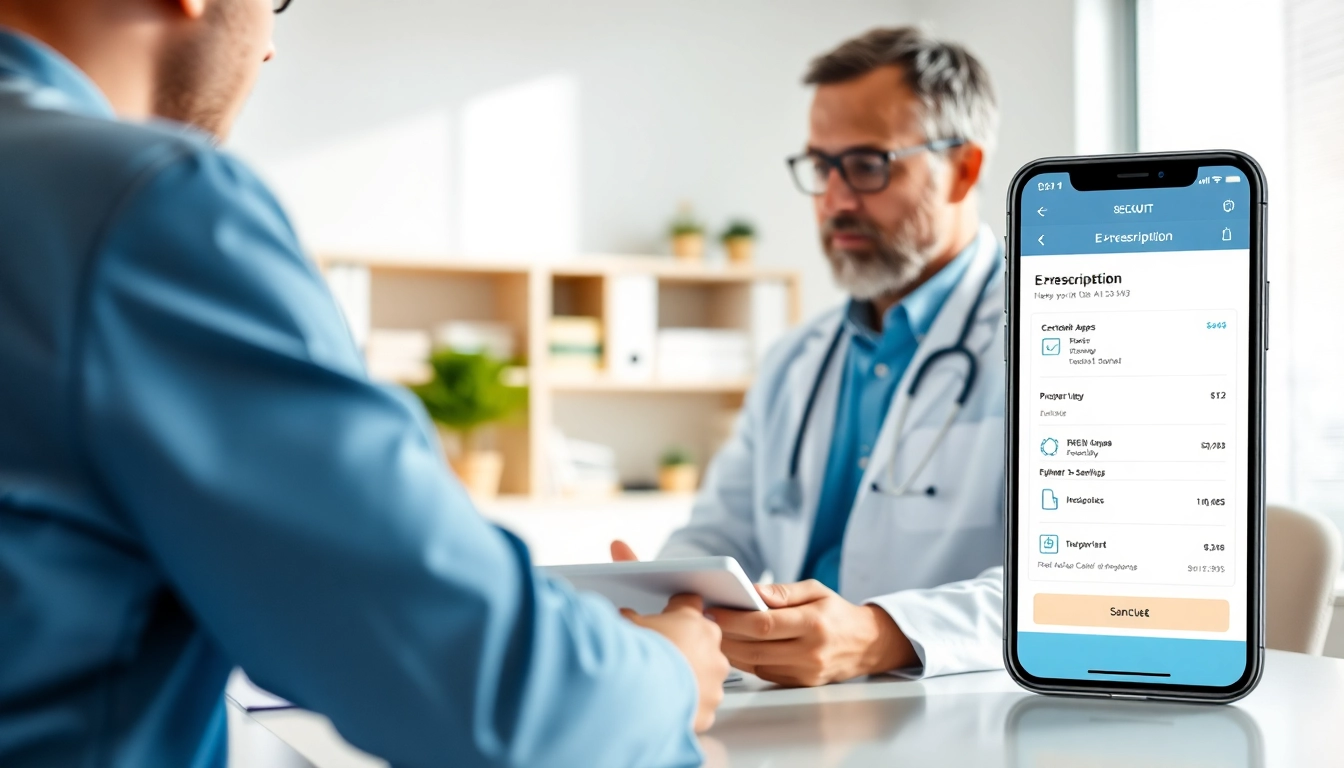Understanding E-Prescription Apps
Definition and Purpose of E-Prescription Apps
E-prescription apps are digital platforms that facilitate the electronic transmission and management of prescriptions between healthcare providers, patients, and pharmacies. These applications are designed to replace traditional paper prescriptions, enabling healthcare professionals to send prescriptions directly to a pharmacy through a secure interface. The primary purpose is to streamline the prescription process, enhancing accuracy, efficiency, and communication while reducing the risk of errors associated with handwritten prescriptions. In an increasingly digital world, advantages of using eprescription apps become apparent through enhanced medication management and patient safety.
Key Features of E-Prescription Technology
Modern e-prescription apps come equipped with several key features that enhance their functionality:
- Secure Transmission: E-prescriptions are sent over secure networks to protect patient confidentiality.
- Medication History Access: Providers can view a patient’s medication history to make informed decisions regarding new prescriptions.
- Drug Interaction Alerts: The systems can alert prescribers about potential drug interactions, allergies, or contraindications.
- Refill Requests: Patients can easily request medication refills through the app, improving adherence and compliance.
- Real-Time Updates: Providers receive notifications about the status of prescriptions, enabling better communication and coordination of care.
The Role of E-Prescription Apps in Modern Healthcare
E-prescription apps play a crucial role in modern healthcare systems by bridging communication gaps between stakeholders. By reducing the need for in-person visits solely for prescription needs, these apps save time for both patients and healthcare providers. They also contribute to better healthcare outcomes through precise medication management and streamlined workflows. This technology is becoming integral to contemporary healthcare practices, contributing to the overall digital transformation within the medical field.
Advantages of Using E-Prescription Apps
Improved Medication Adherence through Reminders
One significant advantage of using e-prescription apps is the enhanced medication adherence facilitated by built-in reminders and notifications. Through these apps, patients receive alerts for medication schedules, dosages, and even prescription refills. Research has shown that such reminders increase the likelihood that patients will follow their prescribed treatment regimens, significantly boosting adherence rates. Enhanced adherence can lead to better health outcomes, particularly for individuals managing chronic conditions such as diabetes or hypertension. This not only benefits patient health but also reduces overall healthcare costs by preventing complications and hospitalizations.
Streamlined Prescription Management for Healthcare Providers
For healthcare providers, e-prescription apps simplify the management of patient prescriptions. By allowing doctors to send prescriptions electronically, these apps eliminate the complications associated with paper prescriptions. There’s no risk of misplaced documents or unreadable handwriting, which can often lead to medication errors. The streamlined process allows healthcare providers to allocate more time to patient care instead of administrative tasks. Furthermore, e-prescription systems often integrate with electronic health records (EHRs), allowing immediate access to patient medical history and enhancing the decision-making process.
Enhanced Patient Engagement and Education
Patient engagement is another crucial advantage of using e-prescription apps. By providing patients with access to their prescriptions, medication instructions, and educational resources, these apps empower them to take an active role in their health care. Patients can learn about their medications, potential side effects, and the importance of adherence, leading to better understanding and management of their health. An engaged patient is more likely to ask questions, seek clarifications, and discuss any issues with their healthcare providers, resulting in improved communication and better health outcomes overall.
Impact on Healthcare Efficiency
Reducing Prescription Errors with Digital Solutions
Prescription errors can have serious consequences for patient safety. E-prescription apps leverage technology to reduce such errors significantly. By automating the prescription process, these apps minimize the chances of misinterpretation or transcription errors often associated with handwritten scripts. Alerts about potential drug interactions or allergies further reinforce safe practices. Studies have demonstrated that systems employing e-prescription technology see a dramatic reduction in adverse drug events compared to traditional prescription methods.
Time-Saving Benefits for Both Patients and Providers
Time efficiency is paramount in healthcare settings. E-prescription apps not only expedite the prescribing process but also reduce waiting times for patients picking up medications. Doctors can quickly send prescriptions to pharmacies ahead of patient visits or directly while consulting, ensuring that patients can collect their medications without unnecessary delays. This expedited process improves the overall flow within healthcare facilities and enhances patient satisfaction, as individuals can potentially avoid long waits both in the clinic and at the pharmacy.
Data Management and Analytics in E-Prescription
E-prescription apps facilitate robust data management and analytics capabilities. With vast amounts of prescription data being processed, providers can gain insights into prescribing patterns, medication usage, and patient outcomes. This data can inform clinical decisions, enable quality improvement initiatives, and support research into medication efficacy. Additionally, analytics can be used to identify at-risk populations requiring targeted interventions, thereby improving health outcomes across different demographics.
Integrating E-Prescription Apps into Healthcare Practices
Steps for Implementing E-Prescription Technologies
Integrating e-prescription apps into existing healthcare practices requires careful planning and execution. The following steps can guide organizations in implementing this technology:
- Needs Assessment: Evaluate the existing prescription processes and identify specific needs and areas for improvement.
- Choosing a Vendor: Select an e-prescription system that meets regulatory requirements and integrates well with existing EHRs.
- Pilot Testing: Conduct a pilot program with a small group of users to troubleshoot issues and gather feedback.
- Full-Scale Implementation: Roll out the system organization-wide, ensuring that all necessary stakeholders are included in the transition.
- Continuous Evaluation: Monitor the system’s performance, solicit feedback, and make adjustments as necessary to ensure optimal functionality and user satisfaction.
Training Healthcare Staff on E-Prescription Systems
Comprehensive training is essential for successful adoption of e-prescription technologies. Staff should be familiarized with the functionalities of the app, including how to enter and manage prescriptions, access patient data, and utilize decision support systems. Continuous training sessions can keep staff updated on features and best practices. Moreover, incorporating feedback loops where users can report difficulties or suggest improvements can enhance user experience and encourage a culture of innovation within the organization.
Overcoming Common Challenges in Adoption
Despite the evident benefits, barriers to adopting e-prescription technology often persist within healthcare settings. Common challenges include resistance to change, technical difficulties, and concerns about data security. Strategies to overcome these challenges include:
- Engagement of Leadership: Involve leadership in advocacy for technology adoption, as their support can motivate staff.
- User-Friendly Interfaces: Choose e-prescription apps that offer intuitive designs, making it easier for users to adapt.
- Data Security Assurance: Provide education on security protocols and the importance of safeguarding patient data to build trust in the system.
Future Trends in E-Prescription Apps
Innovations on the Horizon for E-Prescription
The future of e-prescription apps appears bright, with continuous advancements promising to enhance their capabilities. Trends such as integration with telehealth platforms allow for seamless service delivery, enabling providers to prescribe medications during virtual visits. Additionally, improvements in artificial intelligence could lead to smarter diagnostic tools within e-prescription frameworks, which can assess patient data and suggest optimal prescriptions based on comprehensive analytics.
Patient-Centric Features and Functionality
There is a growing emphasis on patient-centric features in e-prescription apps. Innovative functionalities such as personalized medication plans, in-app consultations with pharmacists, and the ability to track one’s medication adherence through gamification elements are becoming increasingly popular. These enhancements not only improve health literacy but also personalize the patient experience, making the management of medications more engaging and effective.
The Role of Artificial Intelligence in E-Prescription
Artificial intelligence is poised to revolutionize the capabilities of e-prescription apps. The technology can be employed to analyze patient data, predict medication responses, and provide recommendations while considering individual patient characteristics. Enhanced safety protocols through AI can further reduce the likelihood of prescription errors, ensuring that patients receive the most appropriate therapies. As healthcare continues to evolve, the incorporation of AI in prescribing processes will likely become standard practice, leading to personalized medicine tailored to meet individual needs.



